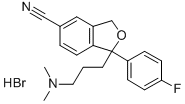Manufacturing Process
5-Carboxy-1-(4-fluorophenyl)-1-(3-dimethylaminopropyl)-1,3-
dihydroisobenzofuranwas synthesized by three methods:
1. A solution of 1-(4-fluorophenyl)-1-(3-dimethylaminopropyl)-1,3-dihydro�isobenzofuran-5-yl magnesium bromide in dry THF (90 mL) (prepared by
ordinary methods from 5-bromo-1-(4-fluorophenyl)-1-(3-
dimethylaminopropyl)-1,3-dihydro-isobenzofuran (9 g, 0.024 mole) and
magnesium (0.73 g, 0.03 mole)) was added to dry solid CO2 (50 g). After
addition, the mixture was left at room temperature for 16 hours. The volatile
materials were removed in vacuo and the residue was taken up in water (100
mL). pH was adjusted to 5.5 by adding HCl (aqueous, 4 N). The aqueous
phase was extracted with toluene (100 mL). The toluene was removed in
vacuo and the 5-carboxy-1-(4-fluorophenyl)-1-(3-dimethylaminopropyl)-1,3-
dihydroisobenzofuran was obtained as oil. Yield 6 g.
2. To a solution of 5-bromo-1-(4-fluorophenyl)-1-(3-dimethylaminopropyl)-
1,3-dihydroisobenzofuran (9 g, 0.024 mole) in tertbutyl methyl ether (150
mL) was added n-BuLi (1.6 M in hexanes, 40 mL) at -78 to -65°C. The
temperature of the solution was allowed to raise to -30°C over a period of 2
hours. The reaction mixture was added to dry solid CO2 (50 g). After addition,
the mixture was left at room temperature for 16 hours. The volatile materials
were removed in vacuo and the residue was taken up in water (100 mL). pH
was adjusted to 5.5 by adding HCl (aqueous, 4 N). The aqueous phase was
extracted with toluene (100 mL). The toluene was removed in vacuo and the
5-carboxy-1-(4-fluorophenyl)-1-(3-dimethylaminopropyl)-1,3-
dihydroisobenzofuran was obtained as an oil. Yield 7.5 g.
3. n-BuLi (20 mL, 1.6 M in hexane) was added to a solution of
isopropylmagnesium chloride (8.0 mL, 2 M in diethyl ether) in THF (25 mL) at
0°C. The resulting mixture was stirred at 0°C for 1 h, then cooled to -78°C
and a solution of 5-bromo-1-(4-fluorophenyl)-1-(3-dimethylaminopropyl)-1,3-
dihydro-isobenzofuran (5.0 g, 13.0 mmol) in THF (25 mL) was added. The
mixture was allowed to warm to -10°C during 1 h, then cooled again to -78°C
and CO2 (5.7 g, 130 mmol) was added. The mixture was allowed to warm to
room temperature, and then evaporated. Ion exchange chromatography of the
residue (Dowex RTM-50, acidic form) eluting with 1 M NH3 afforded the 5-
carboxy-1-(4-fluorophenyl)-1-(3-dimethylaminopropyl)-1,3-
dihydroisobenzofuran as a thick oil.
5-Carboxy-1-(4-fluorophenyl)-1-(3-dimethylaminopropyl)-1,3-
dihydroisobenzofuran (5 g, 0.015 mole) and sulfamide (1.65 g, 0.017 mole)
were dissolved in sulfolane (15 mL). Thionyl chloride (2.25 g, 0.019 mole)
was added at room temperature and the temperature of the reaction mixture
was raised to 130°C for 2 hours. The reaction mixture was allowed to cool to
75°C and water (25 mL) was added. The temperature was held at 75°C for 15
min, and then the reaction mixture was cooled to room temperature. pH was
ajusted to 9 with ammonium hydroxide and then n-heptane (75 mL) was
added. The temperature was raised to 70°C and the hot n-heptane layer was
isolated from which the 5-cyano-1-(4-fluorophenyl)-1-(3-
dimethylaminopropyl)-1,3-dihydroisobenzofuran (Citalopram, free base)
crystallised on cooling. Yield 3.77 g. Purity (HPLC peak area) >97%.
The hydrobromide was prepared in conventional manner and crystallized from
isopropanol; melting point 148-150°C.
General Description
Citalopram is an antidepressant sold under the trade names Celexa? and Cipramil for the treatment of major depression. Citalopram is a selective serotonin reuptake inhibitor, a class of drugs that also includes fluoxetine, paroxetine, and sertraline. This Certified Snap-N-Spike? Solution is suitable for use in LC/MS or GC/MS applications for clinical toxicology, forensic analysis, urine drug testing, or pharmaceutical research.
